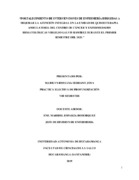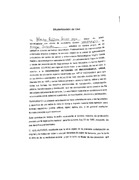Mostrar el registro sencillo del ítem
Fortalecimiento de intervenciones de enfermería dirigidas a mejorar la atención integral en la unidad de quimioterapia ambulatoria del Centro de Cáncer y Enfermedades Hematológicas Virgilio Galvis Ramírez durante el primer semestre del 2020
| dc.contributor.advisor | Esparza Bohórquez, Maribel | spa |
| dc.contributor.author | Serrano Joya, Marilyn Rossana | spa |
| dc.coverage.spatial | Floridablanca (Santander, Colombia) | spa |
| dc.coverage.temporal | 2020 | spa |
| dc.date.accessioned | 2021-02-19T22:11:19Z | |
| dc.date.available | 2021-02-19T22:11:19Z | |
| dc.date.issued | 2020 | |
| dc.identifier.uri | http://hdl.handle.net/20.500.12749/12243 | |
| dc.description.abstract | Según Proyecciones de la Organización mundial de la salud (OMS) se estima que al 2030 las incidencias de casos nuevos de cáncer aumenten significativamente, este proceso patológico es considerado actualmente como un grave problema de salud pública y no solo por ser una de las primeras causas de muerte en el mundo sino también por el impacto a nivel psicológico que causa en esta población. Un soporte oncológico confiere una visión holística en la atención, haciendo a la familia una parte esencial del proceso tanto como objeto del cuidado como recurso que facilita la adherencia al tratamiento, por esta razón es importante la intervención y el apoyo de enfermería en la gestión de una visión integral, incluyendo el abordaje del paciente y de su familia como unidad de tratamiento, ya que el suministro de información apropiada y suficiente conforman la organización de un programa de educación lo cual se debe considerar como elemento sustancial en el modelo del cuidado oncológico. OBJETIVO: Implementar un plan de mejora desde un enfoque holístico basado en adherencia a protocolos institucionales, educación y apoyo emocional al usuario promoviendo el cuidado humanizado en el centro de cáncer – Foscal durante el segundo semestre del año 2019. METODOLOGIA: El plan de mejora es un proceso fundamental para alcanzar la calidad y excelencia en los procesos, esto es llevado a cabo tras realizar una valoración y hallar un diagnóstico del sitio, en este caso, fue usada la estrategia FODA por ser la herramienta apropiada para conocer las condiciones reales del lugar de practica relacionadas a fortalezas, oportunidades, debilidades y amenazas, tras tener esta valoración se procede a realizar un proceso de priorización de las debilidades encontradas para finalmente encontrar necesidades a trabajar, en este caso se usó la herramienta de priorización parilla de análisis la cual tiene en cuenta cuatro aspectos del problema a analizar: Importancia sanitaria y/o que se refiere a la frecuencia y/o gravedad del problema, relación entre este y los factores de riesgo; capacidad técnica de resolución del problema y factibilidad del programa de intervención. | spa |
| dc.description.tableofcontents | RESUMEN................................................................................................................................ 6 ABSTRACT .............................................................................................................................. 8 INTRODUCCIÓN ................................................................................................................... 10 JUSTIFICACIÒN .................................................................................................................... 11 OBJETIVOS ........................................................................................................................... 13 OBJETIVO GENERAL ....................................................................................................... 13 OBJETIVOS ESPECIFICOS ............................................................................................... 13 DESCRIPCIÓN GENERAL DE LA FUNDACIÓN OFTALMOLOGICA DE SANTANDER 14 HISTORIA .......................................................................................................................... 14 CENTRO DE CÁNCER Y ENFERMEDADES HEMATOLÓGICAS VIRGILIO GALVIS RAMÍREZ ............................................................................................................................... 15 DESCRIPCIÓN DEL SITIO DE PRÁCTICA ...................................................................... 15 RECURSO HUMANO ........................................................................................................ 16 DIRECCIONAMIENTO DE LA FUNDACIÓN OFTALMOLÓGICA DE SANTANDER -FOSCAL ................................................................................................................................. 18 Misión: ................................................................................................................................ 18 Visión: ................................................................................................................................. 18 Objetivos institucionales: ..................................................................................................... 18 Principios institucionales:..................................................................................................... 18 Valores institucionales: ........................................................................................................ 19 POLÍTICA AMBIENTAL ECOFOS-NATURALMENTE SALUDABLE .............................. 20 VALORACIÒN DEL AREA DE TRABAJO .......................................................................... 21 MATRIZ DOFA .................................................................................................................. 21 FORTALEZAS .................................................................................................................... 22 DEBILIDADES ................................................................................................................... 23 OPORTUNIDADES ............................................................................................................ 23 AMENAZAS ....................................................................................................................... 24 PLANEACIÓN .................................................................................................................... 24 PRIORIZACIÓN DE PROBLEMAS ................................................................................... 25 PROBLEMAS PRIORIZADOS Y CATEGORIZADOS A PARTIR DEL MÉTODO HANLON. ........................................................................................................................... 27 PLAN DE MEJORAMIENTO ................................................................................................ 28 3 OBJETIVO GENERAL ....................................................................................................... 28 OBJETIVOS ESPECIFICOS ............................................................................................... 28 PLANEACIÓN DE ACTIVIDADES ................................................................................... 28 PROBLEMA 1..................................................................................................................... 28 PROBLEMA 2..................................................................................................................... 31 PROBLEMA 3..................................................................................................................... 38 COMPONENTE INVESTIGATIVO ....................................................................................... 41 Resumen .............................................................................................................................. 41 ACTIVIDADES COMPLEMENTARIAS ............................................................................... 43 ACTIVIDADES REALIZAADAS EN LA UNIVERSIDAD: .............................................. 43 ACTIVIDADES REALIZADAS EN LA FOSCAL:............................................................. 43 ACTIVIDADES EN CUARENTENA: ................................................................................ 43 CONCLUSIONES ................................................................................................................... 44 RECOMENDACIONES .......................................................................................................... 45 CRONOGRAMA DE ACTIVIDADES ................................................................................... 46 REFERENCIAS ...................................................................................................................... 47 ANEXOS ................................................................................................................................ 48 IMÁGENES......................................................................................................................... 48 | spa |
| dc.format.mimetype | application/pdf | spa |
| dc.language.iso | spa | spa |
| dc.rights.uri | http://creativecommons.org/licenses/by-nc-nd/2.5/co/ | * |
| dc.title | Fortalecimiento de intervenciones de enfermería dirigidas a mejorar la atención integral en la unidad de quimioterapia ambulatoria del Centro de Cáncer y Enfermedades Hematológicas Virgilio Galvis Ramírez durante el primer semestre del 2020 | spa |
| dc.title.translated | Strengthening nursing interventions aimed at improving comprehensive care in the outpatient chemotherapy unit of the Virgilio Galvis Ramírez Center for Cancer and Hematological Diseases during the first half of 2020 | spa |
| dc.degree.name | Enfermera / Enfermero | spa |
| dc.publisher.grantor | Universidad Autónoma de Bucaramanga UNAB | spa |
| dc.rights.local | Abierto (Texto Completo) | spa |
| dc.publisher.faculty | Facultad Ciencias de la Salud | spa |
| dc.publisher.program | Pregrado Enfermería | spa |
| dc.description.degreelevel | Pregrado | spa |
| dc.type.driver | info:eu-repo/semantics/bachelorThesis | |
| dc.type.local | Trabajo de Grado | spa |
| dc.type.coar | http://purl.org/coar/resource_type/c_7a1f | |
| dc.subject.keywords | Nursing | eng |
| dc.subject.keywords | Care of the sick | eng |
| dc.subject.keywords | Medicine | eng |
| dc.subject.keywords | Nursing interventions | eng |
| dc.subject.keywords | Comprehensive care | eng |
| dc.subject.keywords | Outpatient chemotherapy unit | eng |
| dc.subject.keywords | Customer service | eng |
| dc.subject.keywords | Health institutions | eng |
| dc.subject.keywords | Patient satisfaction | eng |
| dc.subject.keywords | Quality of health care | eng |
| dc.identifier.instname | instname:Universidad Autónoma de Bucaramanga - UNAB | spa |
| dc.identifier.reponame | reponame:Repositorio Institucional UNAB | spa |
| dc.type.hasversion | info:eu-repo/semantics/acceptedVersion | |
| dc.rights.accessrights | info:eu-repo/semantics/openAccess | spa |
| dc.rights.accessrights | http://purl.org/coar/access_right/c_abf2 | spa |
| dc.relation.references | Pablo Monje, Paulina Miranda, Jessica Oyarzun, Fredy Seguel, Elizabeth Flórez, Percepción del cuidado humanizado, [Internet] Scielo 2018 [Citado 2019 Agosto 3] Disponible en :https://scielo.conicyt.cl/scielo.php?script=sci_arttext&pid=S0717-95532018000100205 | spa |
| dc.relation.references | Pablo Monje, Paulina Miranda, Jessica Oyarzun, Fredy Seguel, Elizabeth Flórez, Percepción del cuidado humanizado, [Internet] Scielo 2018 [Citado 2019 Agosto 3] Disponible en: https://scielo.conicyt.cl/scielo.php?script=sci_arttext&pid=S0717-95532018000100205 | spa |
| dc.relation.references | Margarita Poblete Troncoso, Sandra Valenzuela Suazo, Cuidado Humanizado: un reto para las enfermeras en los servicios hospitalarios [internet] 2017 [citado 2019 agosto 3], disponible en: http://www.scielo.br/pdf/ape/v20n4/18.pdf | spa |
| dc.relation.references | Rosa Guerrero, Mónica Elisa Meneses, María de la Cruz, Cuidado humanizado de enfermería según la teoría de Jean Watson [internet] 2015, [citado 2019 agosto 3] disponible en: http://www.upch.edu.pe/vrinve/dugic/revistas/index.php/RENH/article/viewFile/3017/2967 | spa |
| dc.relation.references | Jose Asua, Jorge Taboada, Red de investigación de resultados en salud y servicios sanitarios, experiencias en instrumentos de priorización, [internet] [citado 2019 agosto 4], disponible en: https://www.sergas.es/Docs/xornadasQS/Iryss.pdf | spa |
| dc.relation.references | Oliveros, E., Barrera, M., Martínez, S., & Pinto, T. (2010). Afrontamiento ante el diagnóstico de cáncer. Revista de Psicología GEPU, 1 (2), 19 - 29. | spa |
| dc.relation.references | Macias M, Madariaga C, Amaris M, Zambrano J. Individual and family copying strategies when facing psychological stress situations, Vol 30, 2013. | spa |
| dc.relation.references | Jaen P, Truchuelo Maria, Sanmartin Onofre, Guia de cuidados dermatologicos del paciente oncológico, (2012), disponible en: http://gedet.aedv.es/wp-content/uploads/2015/09/El_cancer_y_la_piel.pdf. | spa |
| dc.contributor.googlescholar | https://scholar.google.es/citations?user=hPqcKLAAAAAJ&hl=es&oi=ao | * |
| dc.subject.lemb | Enfermería | spa |
| dc.subject.lemb | Atención al enfermo | spa |
| dc.subject.lemb | Medicina | spa |
| dc.subject.lemb | Servicio al cliente | spa |
| dc.subject.lemb | Instituciones de salud | spa |
| dc.subject.lemb | Satisfacción del paciente | spa |
| dc.subject.lemb | Calidad de la atención de salud | spa |
| dc.subject.lemb | Profesionales de la salud | spa |
| dc.identifier.repourl | repourl:https://repository.unab.edu.co | spa |
| dc.description.abstractenglish | According to projections of the World Health Organization (WHO) it is estimated that by 2030 the incidences of new cases of cancer will increase significantly, this pathological process is currently considered a serious public health problem and not only because it is one of the first causes death in the world but also because of the psychological impact it causes on this population. An oncological support confers a holistic vision of care, making the family an essential part of the process both as an object of care and as a resource that facilitates adherence to treatment, for this reason nursing intervention and support is important in the management of a comprehensive vision, including the approach to the patient and his family as a treatment unit, since the provision of appropriate and sufficient information makes up the organization of an education program, which should be considered as a substantial element in the cancer care model. OBJECTIVE: Implement an improvement plan from a holistic approach based on adherence to institutional protocols, education and emotional support to the user, promoting humanized care in the cancer center - Foscal during the second semester of 2019. METHODOLOGY: The improvement plan is a fundamental process to achieve quality and excellence in the processes, this is carried out after carrying out an assessment and finding a diagnosis of the site, in this case, the SWOT strategy was used as it is the appropriate tool to know the real conditions of the place of practice related to strengths, opportunities, weaknesses and threats, after having this assessment, a process of prioritization of the weaknesses found is carried out to finally find needs to work, in this case the analysis grid prioritization tool was used which has consider four aspects of the problem to be analyzed: Health importance and / or that refers to the frequency and / or severity of the problem, the relationship between it and the risk factors; technical capacity to solve the problem and feasibility of the intervention program. | eng |
| dc.subject.proposal | Intervenciones de enfermería | spa |
| dc.subject.proposal | Atención integral | spa |
| dc.subject.proposal | Unidad de quimioterapia ambulatoria | spa |
| dc.type.redcol | http://purl.org/redcol/resource_type/TP | |
| dc.rights.creativecommons | Atribución-NoComercial-SinDerivadas 2.5 Colombia | * |
| dc.coverage.campus | UNAB Campus Bucaramanga | spa |
| dc.description.learningmodality | Modalidad Presencial | spa |
Ficheros en el ítem
Este ítem aparece en la(s) siguiente(s) colección(ones)
-
Enfermería [161]



